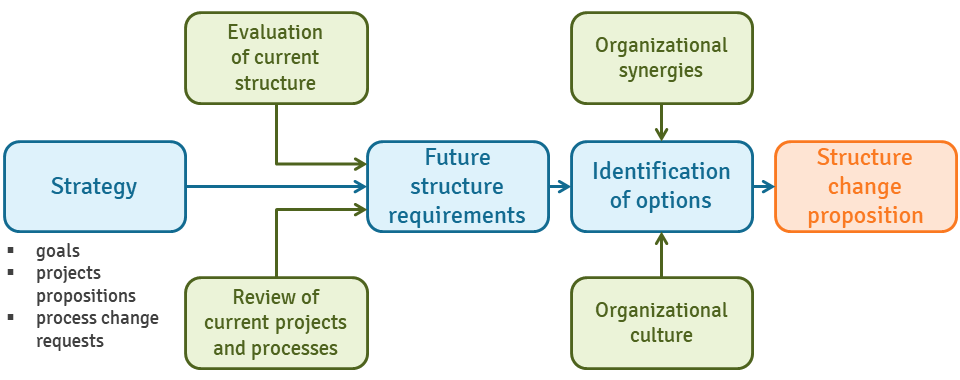Structure follows strategy
Structure follows strategy is a business principle coined by A.D. Chandler in 1962 that states that organizational structure of corporation (the divisions, departments, teams, processes and technology) are designed to achieve a firm's strategy. Chandler covered the crucial role of the company's strategy and pointed to the close relationship between the company's strategy and structure thanks to the research conducted on US corporations operating in the years 1850-1920. Chandler is the author of the quote: If the structure does not support the strategy, the result is inefficiency. He described the strategy as a way to set long-term goals and understood the structure as a way of operating the organization through which the strategy should be implemented. His observations were accurate, as they described the problems of modern American business. American business at the time created many monopolists, who began to lose their dynamism and competitiveness due to the excessive bureaucracy and internal activities that acted to the detriment of customers.
Reasons of existence of this relationship was that:
- employees and resources is key factor of every strategy, and need to be acquired in order to achieve its goals
- proper division of work in form of functional structure and departmental structure increase efficiency of strategic actions
- growth of the firm and acquisition of new markets require strong organizational basis
Contents
- 1 The 7-S framework
- 2 Example of Structure follows strategy
- 3 When to use Structure follows strategy
- 4 Steps of implementing strategy based structure
- 5 Advantages of the approach
- 6 Limitations of the approach
- 7 Other approaches related to Structure follows strategy
- 8 References
The 7-S framework

Fig.1. Structure follows strategy as process
In the current world of fast-growing development, an organization must be flexible to be able to adapt to changing requirements, environments and technologies. The most important challenge of modern times is to create such a structure of the organization so that it is not necessary to redesign it all the time when the parameters like product or customer type changes. Activities are based on solutions that enable reorientation of new challenges and opportunities without the need to introduce drastic changes in the existing structure and functions. Effective organizational change results not only from the relationship with structure and strategy, but also from the interaction between another factors like systems, style, skills, staff and superordinate goals and its called the S-7 framework (R. H. Waterman, Jr., T. J. Peters, J. R. Philips, p. 17-18).
The seven factors for effective strategy execution (R. S. Kaplan 2005, p. 1):
- Structure - the way of formal organization of the company according to the division into positions, departments and other organizational units and delegating duties and information flow between them,
- Strategy - is a program of the company's activity that uses production potential and resources to achieve the intended goals and strengthens its position in relation to the competition,
- Systems - formal and informal procedures for managing the organization, e.g. management control systems, planning systems, information systems, budgeting systems, social systems,
- Staff - people who create the organization and their competences,
- Skills - a company's crucial attributes, areas that distinguish its from others,
- Style - the organizational culture (the values, the norms),
- Superordinate goals - a set of values and aspirations, fundamental ideas around which a business is built.
Example of Structure follows strategy
One example of structure following strategy is Amazon, which has adopted a flat structure to support its focus on innovation and customer service. The flat structure allows Amazon to respond quickly to customer feedback and make changes to its products accordingly. Additionally, it allows employees to work more closely together on projects, which helps them to be more innovative. The flat structure also allows Amazon to remain agile and adjust to changes in the external environment quickly.
In conclusion, Amazon is an example of structure following strategy. Its flat structure helps it to remain agile and respond quickly to customer feedback and changes in the external environment. This structure allows Amazon to remain focused on innovation and customer service, which supports its overall strategic objectives.
When to use Structure follows strategy
Structure follows strategy is an important business principle that should be used when the organization is making changes to its strategy. This principle helps organizations to ensure that their structure is closely aligned with the strategy to ensure that it supports the objectives and goals of the business. Additionally, this principle helps organizations to remain flexible to changes and respond quickly to the external environment.
It is important to note that structure follows strategy should not be used as a substitute for a good strategy. Organizations should ensure that they have an appropriate strategy in place before making changes to their structure. Additionally, organizations should ensure that their structure supports their strategy, not the other way around.
Steps of implementing strategy based structure
- Defining the strategy: The first step to implementing structure follows strategy is to clearly define the strategy of the organization. This should include a clear set of objectives and goals as well as a plan for how to reach those objectives.
- Aligning the structure: Once the strategy has been defined, the organization must align its structure with that strategy. This involves making changes to the organization’s structure so that it supports the strategy and helps to reach the objectives and goals.
- Analyzing the impacts: Once the structure has been aligned with the strategy, the organization should analyze the impacts of the change. This involves evaluating the potential impacts of the new structure on the organization’s performance and making any necessary adjustments to ensure that the structure is properly supporting the strategy.
- Monitoring the results: The final step of structure follows strategy is to monitor the results of the changes. This involves tracking the results of the new structure and making adjustments as needed to ensure that the structure is still properly aligned with the strategy and helping to reach the objectives and goals of the organization.
Advantages of the approach
- Improves agility: By having a structure that is closely aligned with the strategy, organizations can quickly respond to changes in their external environment. This helps them to stay competitive and remain agile.
- Focuses resources: By having a structure that is closely aligned with the strategy, organizations can ensure that they are not wasting time or resources on activities that are not helping them reach their objectives. This helps them to focus their resources on activities that are most likely to help them reach their strategic objectives and goals.
- Supports objectives: The idea of structure following strategy allows organizations to better focus their resources on their strategic objectives and goals. This helps them to remain focused and achieve their desired outcomes more quickly.
Limitations of the approach
Despite the advantages of structure following strategy, there are some limitations to consider. First, the structure of an organization may not be able to fully support the strategic objectives and goals of the business. Second, it can be difficult to align the structure of the organization with the strategy chosen. Third, the structure of the organization may limit the ability to respond to external changes. Finally, the structure of the organization may not be able to keep up with the rapid changes in the external environment.
- Resource-based view: The resource-based view is an approach that focuses on the resources, capabilities and competencies of an organization to gain a competitive advantage. This approach encourages organizations to identify and focus on their unique resources and capabilities in order to gain a competitive advantage in the market.
- Core competencies: Core competencies are the resources and capabilities that an organization has that are difficult for competitors to imitate or replicate. This approach encourages organizations to identify and focus on their core competencies in order to gain a competitive advantage in the market.
- Balanced Scorecard: The Balanced Scorecard is a management tool that uses key performance indicators to measure an organization’s performance. This approach encourages organizations to use performance measures to evaluate their strategies and make adjustments in order to achieve their objectives and goals.
In conclusion, structure follows strategy is a business principle that encourages organizations to align their structure with the strategy they have chosen to pursue. There are also several related approaches that organizations can use to gain a competitive advantage in the market. These include the resource-based view, core competencies, and the Balanced Scorecard. All of these approaches help organizations to strategically manage their resources and capabilities in order to gain a competitive advantage.
| Structure follows strategy — recommended articles |
| Strategic management — Organization life cycle — Beam of objectives theory — Goal intensity matrix — Organizational planning — Business motivation model — Definition of controlling — Importance of strategic management — Tactical plan |
References
- Chandler, A. D. Jr. (1962). Strategy and Structure: Chapters in the History of the American Industrial Enterprise. Cambridge, MA: MIT Press
- Hall, D. J., & Saias, M. A. (1980). Strategy follows structure!. Strategic management journal, 1(2), 149-163.
- Waterman R. H. Jr., Peters T. J., Philips J. R. (1980). Structure Is Not Organisation. Business Horizons.
Author: Anna Gołdyn
.

